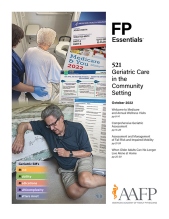
This clinical content conforms to AAFP criteria for CME.
By 2030, 1 in 5 Americans will be older than 65 years, and the health care system will need to prioritize disease prevention in these patients to help them maintain their health. The Welcome to Medicare visit and Annual Wellness Visits (AWVs) were established to provide the opportunity for clinicians to screen older adult patients for geriatric conditions, review and implement preventive health recommendations, and create an individualized plan for health promotion for the next 5 to 10 years. Any patient enrolled in Medicare Part B is eligible for these visits. They focus on assessment of medical risks, drug use, lifestyle and health habits, functional status, cognitive status, mobility, mental health, and end-of-life planning. The main difference between these types of visits is that AWVs include a formal Health Risk Assessment to guide further screening and evaluation. To perform these visits efficiently, medical team staff members must understand what is required, adequate time must be allocated, and different team members should perform different parts of the evaluation. In addition to increasing the rates at which older adult patients receive recommended preventive care, these visits can generate revenue for practices if the required elements are performed, documented, and billed correctly.
Case 1. HK is a 70-year-old man with hyperlipidemia, hypertension, and osteoarthritis who has been your patient for several years. HK presents today for an Annual Wellness Visit (AWV). The medical student working with you asks if this is a regular physical examination or something else.
Subscribe
From $350- Immediate, unlimited access to FP Essentials content
- 60 CME credits/year
- AAFP app access
- Print delivery available
Edition Access
$44- Immediate, unlimited access to this edition's content
- 5 CME credits
- AAFP app access
- Print delivery available
